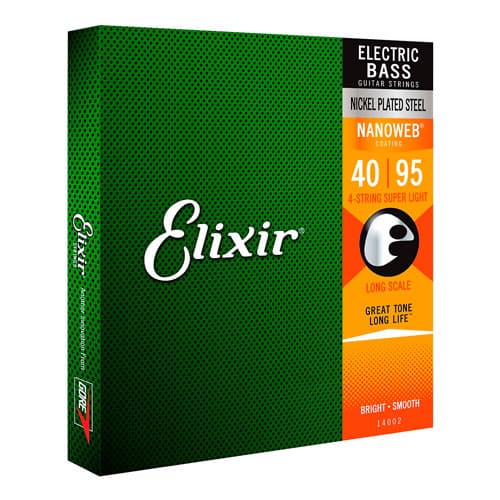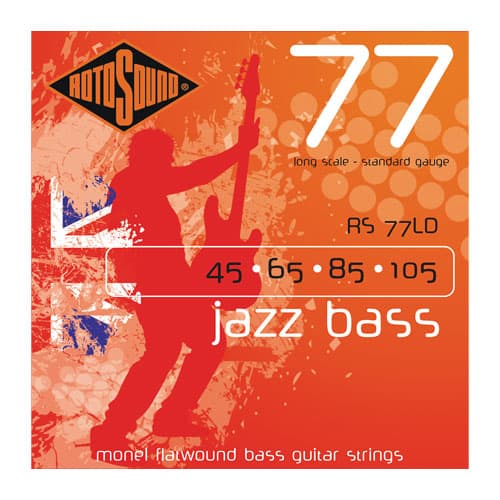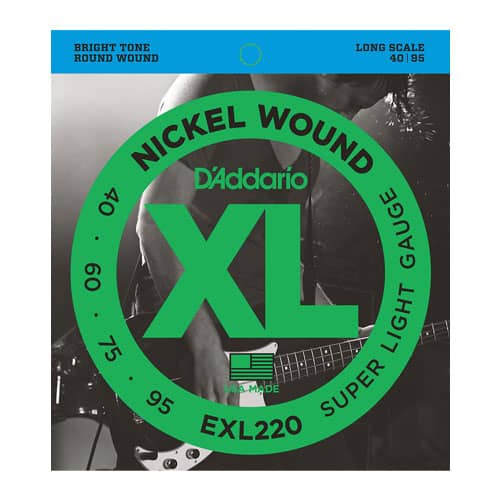Table of Contents
How important are bass strings, really?
If awesome tone is what you’re after, slapping on a decent set of strings will make a crazy difference.
There are a lot of materials, windings and thicknesses to consider, all of which can turn an average bass guitar into a tone monster!
To help you explore the different options available, I’ve selected 9 of the most awesome bass strings for a close up review.
Top 9 bass strings for all music styles:
| Image | Bass Strings | Summary | Check Price |
|---|---|---|---|
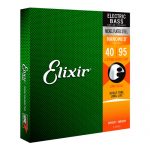 | Elixer Nickel Plated Nanoweb | Best Choice: Well designed to provide punch and tone, while also having a long lifespan | Check price |
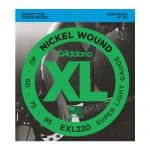 | D'Addario EXL220 Super Light | Best Value: Really easy to get along with for a majority of music styles, while being really affordable | Check price |
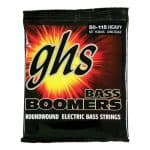 | GHS Bass Boomers | Best for Heavy Metal: Thicker gauge strings which deliver on those hard rock tones | Check price |
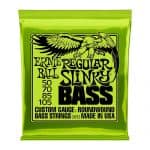 | Ernie Ball Regular Slinky | Best All Rounder: A good middle ground option between playability and punchy tone | Check price |
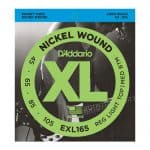 | D'Addario EXL165 Hybrid | Best Hybrid Option: A nice fat bottom end and lighter gauge tops which work well for funk and slap music styles | Check price |
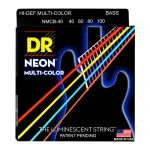 | DR NMCB-40 Neon | Most Creative Flair: Not just for looks, these coated strings have a long life span and sound pretty good too | Check price |
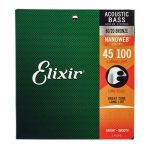 | Elixer 80/20 Bronze Acoustic | Best Acoustic Option: Designed for acoustic bass guitars with a lot of punchy tone and a coating built to last | Check price |
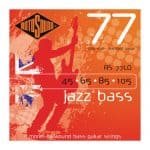 | Rotosound Monel Flatwounds | Premium Pick: Easy on the fingers and zero fret squeak, these flatwound strings are perfect for those warmer, jazzier tones | Check price |
 | D'Addario EPS170 ProSteels | Best Steel Strings: Superb clarity and punch perfect for heavy metal and slap music styles | Check price |
Elixir Nickel Plated NANOWEB coating
If you’re looking for a long-lasting, easy to play set, Elixer’s nickel plated strings with nanoweb coating are a brilliant option.
While they’re not the cheapest set, they do last a very long time. Some bassists get 6 months of hard gigging use, which is amazing compared to average 3 – 5 week lifespan of standard roundwound bass strings.
The super light gauge (.040 .060 .075 .095) make these suitable for beginner bass players who are still developing their fretting techniques, while also looking to get a consistently great sound.
Positives
- Super light string gauge and smooth coating make for very easy playing
- Corrosion and dirt resistant which means less string changes required
- Lovely balanced tone between warmth and brightness
Negatives
- Coated strings are generally more expensive (but do last longer)
D'Addario EXL220
The EXL220 range are some of my favorites. The tone quality is nice and bright. Perfect for slap bass and funk, while also having plenty low end growl.
Although these are the super light gauge (.040 .060 .075 .095), I personally don’t find they lose too much sustain or volume.
The big advantage with this string gauge is how easy they are to play, making it suitable for beginners too.
Typical of uncoated roundwound strings, you get a good level of grip (quite rough to the touch) which produces more fret squeak as you slide from note to note.
But, if you are looking for an inexpensive, easy to play string set, the EXL220 makes for a great option too.
Positives
- Bright and poppy tone, amazing for slap bass and funk music
- Some of the cheapest bass strings on the market
- Tried and tested by hundreds of bass players over many years
Negatives
- Tend to have a shorter lifespan than coated bass strings
GHS BASS BOOMERS H3045
If you’re a metal or hard rock fan, you’ll probably love the GHS Bass Boomers string set (.050 .070 .095 .115).
These are aggressive, power strings which give off a ton of sustain, brightness and deep bass tone.
As there is a lot more tension across the neck, drop tuning is really easy to do without getting any unwanted fret buzz or twang.
I wouldn’t recommend using these bass strings on any vintage bass guitars or weak necks which require lighter handling.
If you are a beginner, you might find heavy gauge strings difficult to play at first. But, with enough practice, you’ll get into it.
Positives
- Brilliant brightness and deep low-end bass tones
- Perfect for alternative lower tunings. For example, Drop D
- Not too expensive
Negatives
- High tension on the neck means less suited to vintage models
- Not the easiest to fret or play for beginners
Ernie Ball Regular Slinky
The regular gauge Ernie Ball slinky bass strings (.050 .070 .085 .105) are a nice balance between tone and easy playability.
The winding is made up of a nickel plated steel over a hex core which provides well rounded level of crisp brightness and deep low end.
The big positive of medium gauge strings is the versatility to play a wide range of music styles comfortably.
If you have your strings set low to the fretboard, you’re also likely to get less fret buzz and twang.
Positives
- Great all rounder for a diverse range of playing styles
- Awesome tone balance between brightness and warmth
- Affordable price point
Negatives
- Not as long of a lifespan compared to coated strings
D'Addario EXL165
What if you are looking for a fat bottom end with a sharp and crisp pop?
D’Addario EXL165 bass strings provide the best of two worlds with a mix of light and medium gauge bass strings that provide a wide range of tonality (.045 .065 .085 .105).
Lighter strings are much easier to ‘pop’ when getting your funk on. The heavier bottom end are not too hard on the fingers either, but produce a much better lower end thump.
If you’re a beginner looking to explore tone and slightly heavier gauges, a set of hybrids are a great option to try out.
Positives
- Great balance of warmth, punch and brightness
- Excellent gauge for slap bass and funk music with extra thump on the low end
- Not too expensive
Negatives
- Not as long of a lifespan compared to coated bass strings
DR NMCB-40 DR NEON
If you’re looking to get a set of long-lasting bass strings which also get a lot of attention, the DR Neon’s are an awesome option!
But, they’re not just for show, the light gauge (.040 .060 .080 .100) gives a decent bright tone with a good level of warmth.
If you are a beginner, you’ll also find the lighter gauge makes for easier fretting and playing.
The string texture is similar to standard roundwound strings, but a lot smoother with the added coating.
The tone may be on the warmer side, but still works perfectly well for a wide range of music styles.
And who doesn’t want to glow in the dark!?
Positives
- Coated strings have a great lifespan
- Lighter gauge is friendly to beginners and shredders
- Colours match all the clothes in your wardrobe
Negatives
- Quite expensive but they do last a long time
- Not as much sustain or volume compared to uncoated strings
Elixir 80/20 Bronze NANOWEB
To get a rich, bright and punchy tone from your acoustic, a set of light Elixer bronze strings are a great option.
Even though these strings are coated, they are a lot brighter than you might expect with a decent level of mellow warmth.
The coating keeps the strings fresh for a long time, which means less bass string changes required.
The smooth texture also gets rid of fret squeak which you normally get on standard roundwound strings.
As with all light gauge combinations, the Elixer acoustic range (.045 .065 .080 .100) makes these strings easy to fret and play, overall a great option for acoustic lovers.
Positives
- Corrosive resistant and smooth textured coating
- Good tone balance between brightness and warmth
- Good level of grip while also reducing fret squeak
Negatives
- Not as loud as standard, uncoated roundwound bass strings
- Fairly expensive (although really long lasting)
Rotosound RS77LD
Rotosound flatwounds produce a rich warmth with a good level of brightness.
These are also potentially the best strings for fretless bass, allowing you to slide up and down with no fret squeak.
Although coated roundwounds are smoother than normal, flatwounds are completely silky smooth end to end. The tight spacing between windings also extends the life of the strings as it’s much harder for dirt and moisture to get through.
Even though these are a light/regular hybrid gauge (.045 .065 .085 .105), the neck tension and gauge ‘feel’ with flatwound bass guitar strings will be a lot higher than roundwounds of the same thickness.
Positives
- Classic warm tone perfect for blues, jazz bass and british rock styles of music
- Smoothest playing surface of all winding types
- Brighter than most flatwound bass strings, giving a lovely tone balance
Negatives
- Gauge is heavier than roundwounds of the same thickness
- Higher tension makes flatwounds less suitable for vintage basses
- More expensive than standard roundwounds
D'Addario EPS170
When it comes to delivering bags of brightness and low end punch, a set of pure steel strings is another awesome option.
Steel roundwounds deliver brightness at the top and deep bass in the low end. The mid tones are more flat which makes for a natural ‘mid scoop’ sound.
Even when using lighter gauge strings (.045 .065 .080 .100), the bigger boost in the low end makes up for the volume you normally get with heavy gauge strings.
Steel strings are great for a wide range of music styles, but work especially well in hard hitting music like rock and metal.
If you also do a lot of slap bass, you get a great thump and pop. Amazing to think how much of a difference a set of strings can make!
Positives
- Loud, punchy and bright even on a lighter gauge
- Budget friendly
Negatives
- Can be a little more ‘scratchy’ on fingers and frets
- Tend to lose their brightness and tone quickly
How to choose bass strings
There is a lot of science that goes into it. Whether you are a beginner or bass guitar ninja, it’s definitely useful to have a quick look at the most important parts.
Gauges
Bass string sets come in different thickness (otherwise known as string gauge). Aside from playability, gauge also plays a crucial part in tone.
Let’s geek out for a second and look at some numbers.
String gauge is measured in 1/1000th of an inch. For example, 0.040 makes up the thinnest string and 0.095 makes up the thickest in a set of ‘super light’ strings.
Generally, the thinner the total set of strings, the lighter the gauge.
For example, D’addario EXL220 strings are a ‘super light’ package whereas Ernie Ball Regular Slinky bass strings are a ‘medium’.
Scale Length
Bass necks come in different lengths, which means you need to know which strings will fit your model.
The most common 4 string bass measures 34 – 36” from the bridge to the nut (full scale). 5 string bass guitars might be slightly longer.
As a general rule of thumb, the other sizes are:
- Short Scale: 30 to 32”
- Medium Scale: 32 to 34”
- Extra Long Scale: 36”+
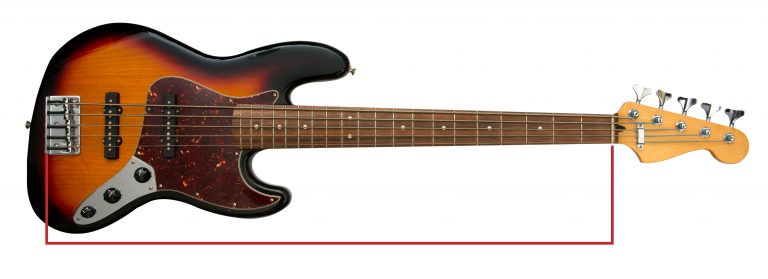
Bridge or Tailpiece
Where the ball end of Bass strings are connected. The strings could be attached directly to the Bridge or through the body.
1 of 3Scale Length
The measurement between the back of the Bridge and the Nut i.e. 34 Inches.
If your strings go through the body, add around a half an inch/one inch to the total length measured.
The Nut
The nut floats the strings above the fretboard, and scale length is measured to this point.
String Gauge Playability and Tone
Lighter gauges are easier to play, but they don’t carry as much sustain or volume. They also produce a more ‘twangy’ sound and are more prone to fret buzz (especially if your strings are set ultra low to the fretboard)
Thicker gauges are harder to play, taking more pressure to fret, pluck and slap. But, they do produce a better sound with more volume punch and clarity.
Which string gauge should I use?
- Heavy - Higher string gauges are perfect for heavy metal and rock musicians who also use lower tunings i.e. drop D. Heavier strings also add volume and sustain to acoustic guitars, which is perfect for unplugged sessions.
- Light - Easier to play and beginner friendly, more advanced players find lighter strings are ‘faster’ for producing epic solos and work better for funk and slap. Lighter gauge strings are also better for vintage bass guitars as there is less tension on the neck.
- Medium - A good mix between heavy and light strings which balances tone.
- Hybrid - Combines a lighter gauge set of strings on the top end while adding heavy gauge strings on the bottom end. For example, D’addario EXL165TP vs D’addario EXL170TP
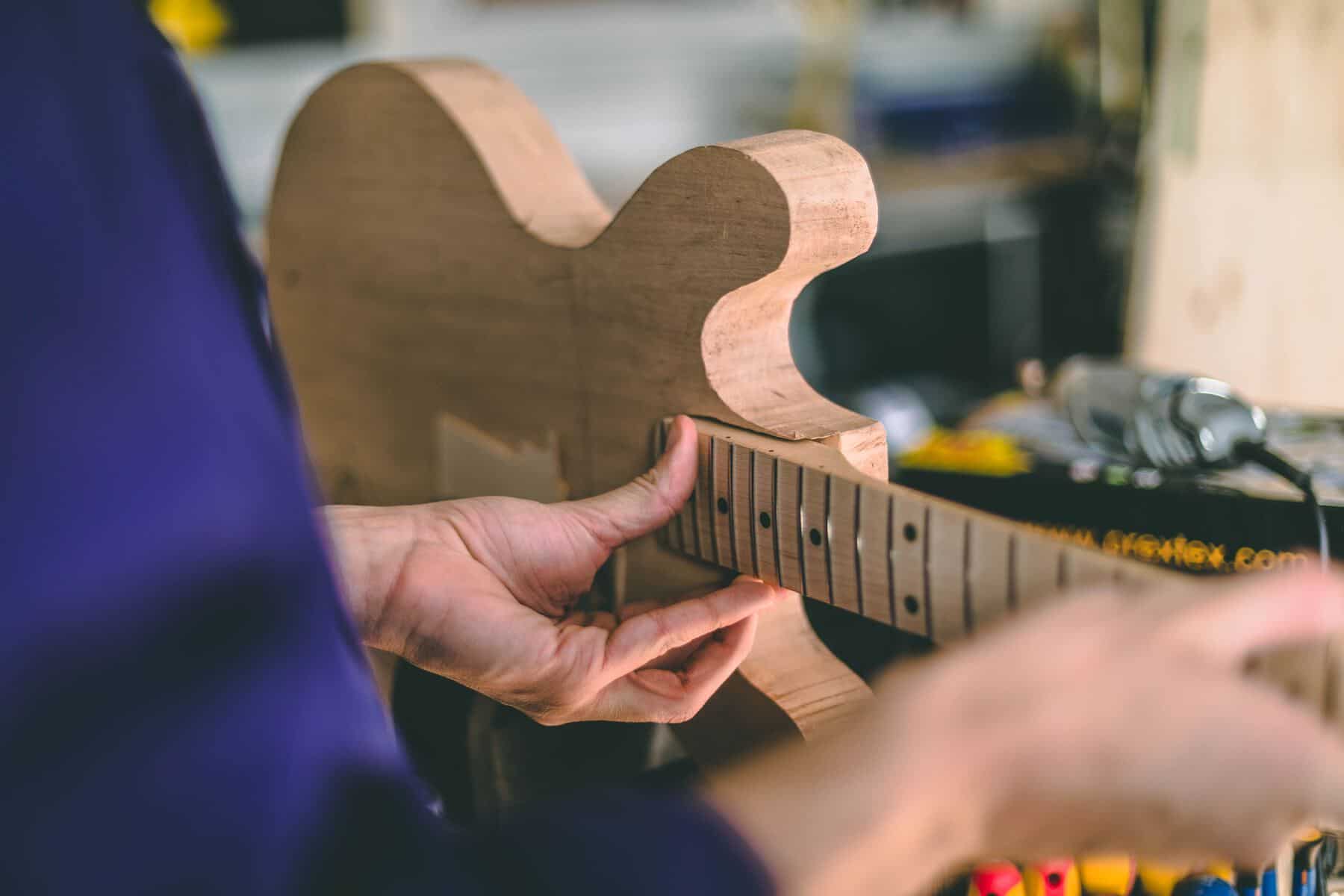
What are the best bass strings?
While there are a few interesting materials (chrome, titanium, cobalt, etc), the most common electric bass guitar strings are either a nickel/steel alloy or pure steel.
Acoustic bass strings are slightly different, as you’ll see below.
- Pure Steel - the brightest tone suited to punchier rock, heavy metal and slap bass. The downside is steel is more ‘scratchy’, your fingers and frets wear down faster than using nickel alloy strings. They also don’t maintain their brightness for long, sounding similar to nickel plated strings after a week or two.
- Nickel Plated Steel - Bright and punchy sound with more warmth. While not as bright as steel when first installed, Nickel/Steel tend to hold their tone over a longer time.
- Pure Nickel - Warm, vintage sound perfect for blues, classic rock and jazz music.
Acoustic Bass Strings
- Bronze - A mix of copper and tin (90/10 or 80/20 ratio) which produces a brighter, sparkly tone.
- Phosphor Bronze - Warmer tone which suits fingerpicking and jazzier styles of music.
Coated Strings
Coated strings include a polymer plastic thinly applied over the exposed outer layer which makes each string smoother to play and protects from corrosion (if you have sweaty hands, for example).
Coated strings are generally more expensive and not as bright sounding. But, they do last longer on tone than uncoated strings which may counter the higher cost.
If you’re keen to stand out and add some creative color to the mix, you could go for a set of NMCB-40 DR strings which glow under neon lights!
Core and String Winding Options
Strings are made up of two parts, an inner core and an outer winding ‘sleeve’. There are a few different cores and winding combinations which produce different sound characteristics.
Types of Core
The core is a single piece of metal wire in either a round or hexagonal shape. Most electric bass string cores are made out of steel. The majority of string sets are made with Hex cores as they’re easier to manufacture, whereas round cores have been around longer.
There are noticeable differences between the two. Hex cores produce a modern, bright tonality with more stable tuning. Round cores offer a warmer, vintage sound perfect for jazz and classic rock music.
Most bass players stick with hex cores which are cost effective and do a great all round job.
Types of Winding
Another important part is the type of outer wire which is tightly ‘wound’ around the core. The three most common winding methods are roundwound, flatwound and halfround which are different shaped metals that produce different sound profiles:
- Roundwound Strings - The most popular type which provides a bright sound and a good amount of finger grip. The wire shape is circular in shape, and also the most commonly installed type on new bass guitars.
- Flatwound Strings - Tightly wound rectangular shape which produces a warm tone while also being resistant to corrosion, dirt and moisture. The surface is smooth to the touch, which is easier on the fingers.
- Halfround Strings - Flat on the outside and round on the inner core side, producing a mix of round and flatwound tones. The added benefit of being smooth to play while still getting a decent level of brightness.
How often should you change bass strings?
Depending on the type of bass strings you use, the most noticeable ‘flag’ is dullness or visible dirt build up on the surface. Old strings have almost no brightness and tend to give off more of a muddled sound.
One problem I’ve seen beginners running into is taking off old strings and not replacing them immediately after. The neck is designed to always be under tension which means if you remove the strings for a long time, you might end up with a permanently warped neck.
So, as a precaution, before you decide to do a string change, make sure you have a new set of strings standing by.
How to change bass strings?
Changing strings is not too difficult, and it only takes a few minutes to complete. The only tool you need is a sharp pair of wire cutters to trim the ends. The process looks something like this:
- Working Area - Find a low traffic area to set down your bass guitar, for example, a table or empty floor space. Layer up a towel or blanket, anything soft enough to protect your bass from getting any scratches while you wrestle with the strings.
- Loosen The Tuning Pegs - Starting at the top of the headstock, loosen the strings evenly (two to three turns per string) until all the strings start to come off the tuning peg. Remove one off at a time and pull it through the bridge or body (depending on your bass layout). You could also cut the strings mid way to prevent each string turning into a deadly whip!
- Clean and Polish - Once all the strings are off, it's a good time for a bit of fret conditioning or cleaning. I recommend giving the neck a wipe down with a slightly damp cloth (or some specially made fret cleaner and oil) and letting it dry for a few minutes.
- Add Back The New Strings - Pull through one string at a time from the bridge end and measure to around 2 inches past the tuner peg. Cut the string at that point, notch into the peg at the cut and start to wind back until you have enough tension over the nut. You shouldn't put full tension on one string at this point, just add enough to be tight over the neck, bridge and nut.
- Tune Up - Once all your strings are back in place, tune up a few turns at a time evenly across the strings until you're back in key. After that, you're ready to rock out. It does take a few days/jam sessions to get the strings into their sweet spot, and you might find it goes out of tune quite a lot for the first few days.

What bass strings should I get?
If you’re feeling adventurous, I’d recommend getting the D’Addario EXL165 Hybrids, Rotosound RS77LD Monel Flatwounds and D’Addario EPS170 ProSteels to test out.
Looking to keep things simple, yet refined? I’d highly recommend going for a set of Elixir Nickel Plated Steel NANOWEB’s which are super well balanced across all departments.
Bottom Line
Well, there you have it! I hope this helps you with a few ideas to try find your unique combination of flavor of tone, punch and brightness.
It does take a few string changes and testing out different string sets to find the ones that suit you best, but overall, it’s a lot of fun to mess around with.
I’d love to hear your thoughts. What are your favorite strings? Have you found any brands or gauges which really work for you and you think other people should try?
Let me know in the comments below!
